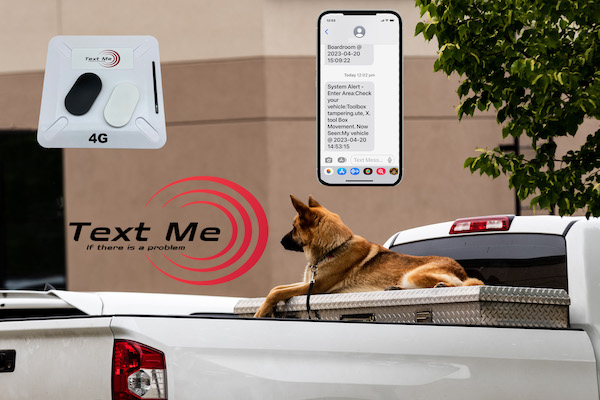To Catch a Thief
Tool thefts from tradies’ vehicles are a nightmare for business owners, insurance companies, and law enforcement professionals – but there are no formal, structured systems in place to address the problem at a state/territory or national level. Therefore, writes JOHN POWER, it’s up to individuals to look after their own equipment… and perhaps help catch a thief in the process.
Tool thefts from vehicles are one of the worst sources of anguish in any plumber’s working life.
The requirement to be constantly vigilant and alert regarding equipment security can be a horrific distraction, particularly amongst sole practitioners working in built-up residential areas, or in commercial settings where constant vehicle surveillance is simply impossible.
Surprisingly, most states and territories do not maintain specific records of thefts from tradie vehicles – Victoria and ACT are exceptions.
In Victoria, data1 shows that 29,000 trade tools worth approximately $20m were stolen in the year to March 2023.
In the ACT, as noted in greater detail below, authorities handle reports of thousands of stolen tool thefts per annum.
Given that Australia’s population is more than four times that of Victoria’s, we can safely extrapolate those data to create an estimate of approximately $80m worth of trade tools stolen Australia-wide from trade vehicles each year.
If we compare tool thefts from trade vehicles with other common classes of crime, such as bicycle thefts2, it is noteworthy that stolen trade tools in Australia are worth almost four times as much as stolen bicycles, which makes the lack of specific data regarding tool thefts from trade vehicles all the more perplexing.
Below we’ll provide an overview of the problem, and outline some meaningful solutions that trade professionals can adopt to deter theft, track stolen goods, or insure themselves against losses.
THIEVES ARE OPPORTUNISTIC
Most tool thefts from vehicles are opportunistic.
If we consider the situation in the ACT, it’s clear that their experiences have undoubted relevance to all other states and territories: “When thieves steal tools, this is typically a crime of opportunity and tends to have little or no premeditation,”said a spokesperson from Australian Capital Territory (ACT) Policing.
“Thousands of dollars’ worth of stolen tools are reported each year in the ACT. In 2023, a total of 2,053 tools were reported as stolen to ACT Policing; and in 2022, a total of 2,938 tools were reported as stolen. Important to note, however, these stats are not necessarily all linked to thefts from vehicles, nor are we able to confirm the occupation of the person reporting the tool/s as stolen.”
Are some suburbs more prone to thefts than others? And do thieves tend to target particular kinds of vehicles?
“There are no specific suburbs or areas in the ACT that are more prone to thefts than others,” the spokesperson explained. “All suburbs and areas in the ACT may and can be targeted.
“And there are no specific types of vehicles that are more prone to thefts than others. All types of vehicles may and can be targeted. Vans tend to be more secure than utes. However, the number one contributing factor to thefts from vehicles is them not being locked – including unlocked storage boxes on utes.”
ACT Policing encourages tradies to secure tools in a safe place out of sight of potential thieves, marking and identifying your tools with a unique identifier, locking toolboxes with a sturdy padlock, and placing GPS trackers on tools where possible (particularly those that are of significant value).
“In addition, we would encourage tradies to stay vigilant and report any suspicious behaviour to site supervisors or Crime Stoppers on 1800 333 000 or via the Crime Stoppers ACT website at crimestoppersact.com.au
The advice to tradies from police in Western Australia is similar: “Any theft of an individual’s personal belongings is of great concern,” said a WA Police Force spokesperson. “In the case of a tradesperson’s tools, this could leave the victim unable to work and in a position of financial instability. The WA Police Force urges any person who has fallen victim to a stealing offence, to report their matter to police.
“Ensure your tools are kept locked up overnight – if possible, ensure the tools cannot be accessed in a public area, particularly overnight.
“Personalised marking on tools may also act as a deterrent, as it may impact an offenders ability to resell stolen tools.
SECURITY DEVICES
While engraved or inked markings written on tools are a self-evident security precaution, sophisticated electronic tracking devices may need some explanation. How do they work?
One of the leading security device providers in Australia is LeashView, which supplies tracking devices such as Leash It tags that can be fitted to tool boxes or even glued to individual tools with a protective cap.
LeashView CEO and Founder Tony Lotzof said tracking tags not only alert owners instantly to theft, but they also have secondary benefits such as digital audit trails, which can be invaluable when filing police reports or making insurance claims.
The tagging system works in concert with the Text Me app on a smartphone.
“The Text Me App works via a 4G Gateway that goes in the vehicle, and small Bluetooth tags that go on the tools or tool boxes and related equipment on or in the vehicle,” Tony said.
Digital security tags like those supplied by LeashView can offer peace of mind to tradies who keep expensive tools in work vehicles.
“You can have as many tags as you like running at the same time. The tags have an extremely sensitive ‘accelerometer’, which means even the slightest bump or movement will cause it to send out a signal. The Text Me Gateway captures that signal and sends a Text Message instantly to a designated mobile phone, alerting to the slightest motion detected from the tool, toolbox, ladders, etc.”
According to Tony, the Text Me solution is Bluetooth-based, has a range up to 50m, and gives an immediate warning if anyone is tampering with tagged items in a vehicle.
As mentioned, additional benefits of fitting Text Me tags is that owners can create a digital, timestamped record of all tags entering and leaving a premises, as well as proving the existence and history of tools on entry and exit.
For tradies seeking more advanced tracking options over unlimited distances, LeashView also supplies a different tag that works with Apple’s Find My app. These tags can be tracked via Apple phones anywhere in the world, and allow owners to track stolen items to a precise location. This information can then be provided to police.
Tags have battery lifespans of 12-26 months, depending on the tag, and range in price from $22 to $35. “The Gateways WIFI/POE for on-premises installation costs $139,” said Tony. “The 4G Gateway is $159, plus there is a $15 SIM connection per month. Tag monitoring and alerts are $3.50 per tag per month.
“Text Me Find My Tags cost $29.”
OTHER DEVICES
There are a number of GPS-based tagging systems available on the market, though size may limit the use of such devices to boxes rather than individual tools. Also, tool companies like Milwaukee have proprietary tool security tracking systems; however, tradies who carry multiple brands of tools and battery platforms may prefer generic tracking systems that can be fitted to any brand of tool.
GET INSURANCE
While vigilance and security measures are the best ways to deter thieves, it pays to prepare for worst-case scenarios: get insurance.
There are a number of specialist insurance companies, as well as larger companies, who are able to offer customised policies to insure trade tools against theft.
In the first instance, you should enquire about ‘trade insurance’ or ‘tool insurance’ to clarify options and costs.
For more information about insuring your trade tools, see the insurance-related articles overleaf.
Footnotes
- See Crime Statistics Agency. Visit https://www.crimestatistics.vic.gov.au/crime-statistics/latest-victorian-crime-data/recorded-offences-2
- Based on $5.8m value of bicycles stolen in Victoria in 2021, see https://bicyclenetwork.com.au/newsroom/2022/12/08/what-weve-learnt-about-bike-thefts-in-victoria/
This article first appeared in Plumbing Connection, Issue #2, 2024.


